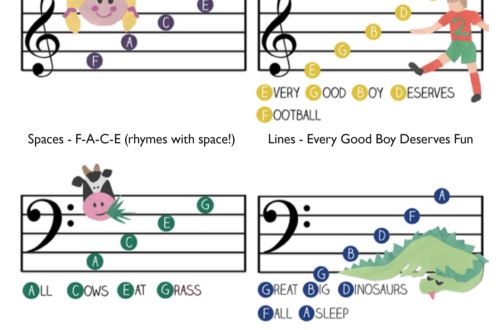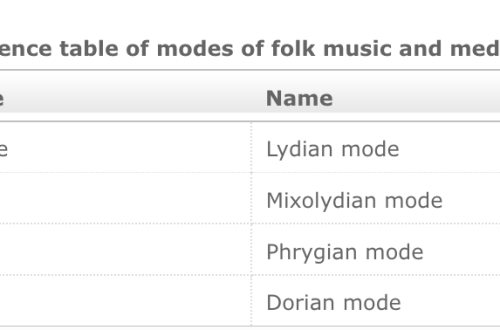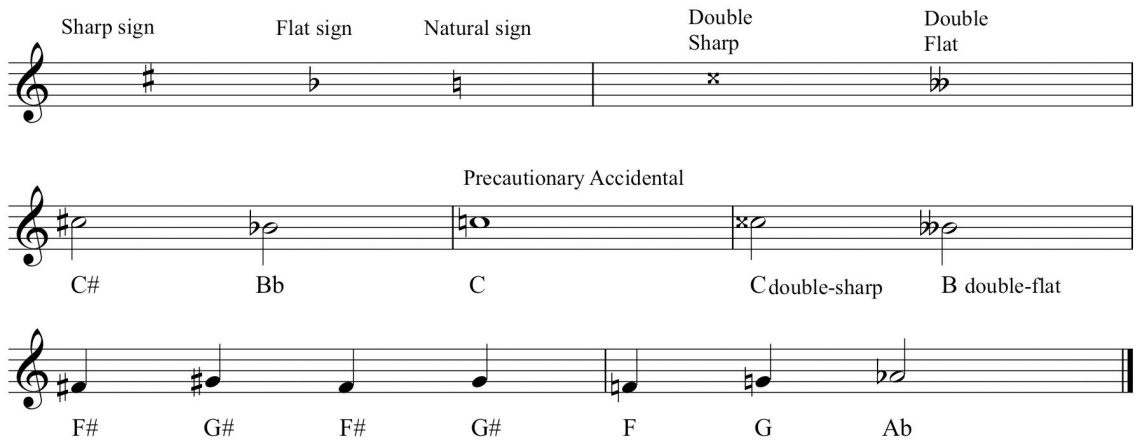
Sharp, flat and bekar – signs of alteration in music
Contents
Today we will talk about what a sharp, flat and bekar are, and about what signs of alteration are in music in general, and what this word “alteration” means in general.
Let’s start with a very brief explanation of everything, and then we will understand thoroughly. Let’s start with our last question, namely – What is alteration in music? This is a Latin word that has the root “ALTER”, you can guess its meaning if you remember any words with the same root. For example, there is such a word as “alternative” (one or another decision to choose from), there is such an expression in psychology as “alter ego” (other me). So, in Latin ALTER means “ANOTHER”. That is, this term always characterizes either the existence of several different variants of a phenomenon or object, or some kind of change.
In music, ALTERATION is a change in the basic steps (that is, a change in ordinary notes DO RE MI FA SOLD LA SI). How can you change them? You can either raise or lower them. As a result, new versions of these musical steps are formed (derivative steps). The higher notes are called DIESES, and the lower ones are called BEMOLS.
Alteration Signs
As we have already noted that NOTES are recorded sounds, that is, graphic signs. And to record the main notes in different octaves, the stave, keys, rulers are used. And for recording changed notes, there are also signs – ALTERATION SIGNS: sharp, flat, bekars, double sharp and double flat.
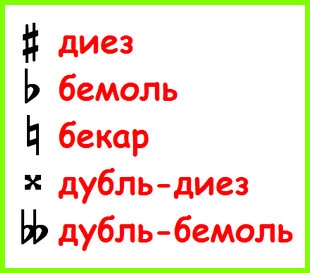
DIEZ sign looks like a grille on a phone keypad or, if you prefer, like a small ladder, it tells us to raise the note. The name of this sign comes from the Greek word “diea”.
BEMOL sign signals us about a lowered note, it looks like an English or Latin printed letter “bh” (b), only the lower part of this letter is pointed (looks like an inverted droplet). Flat is a French word, albeit with a Latin etymology. The term is formed by very simple elements: “be” is the letter “be” (b), and “mole” means “soft”, that is, flat is just “soft b”.
BEKAR sign – a very interesting sign, it cancels the effect of flats and sharps and says that you need to play a regular note, not raised or lowered. By writing, the bekar is slightly angular, it looks like the number 4, only closed at the top not with a triangle, but with a square, and it also looks like the letter “bh” (b), only “squared” and with a stroke down. The name “bekar” is of French origin and translates as “square bae”.
DOUBLE-DIEZ sign, there is one, it is used to double the note, it is a diagonal cross (almost the same as they write when they play tic-tac-toe), only with extended, slightly diamond-shaped tips.
DOUBLE-BEMOL sign, respectively, speaks of a double lowering of the note, the principle of recording this sign is the same as that of the English letter W (double V), it is just that not one, but two flats are placed side by side.
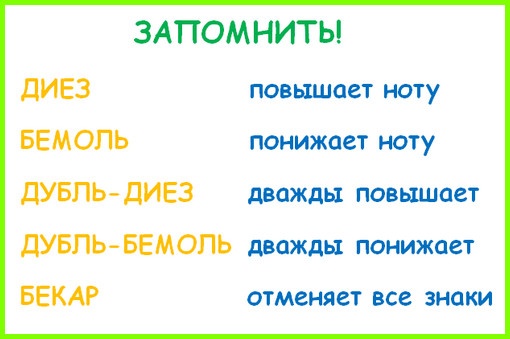
How do sharps and flats change notes?
Let’s start with this observation. Anyone who looks at a piano keyboard will notice that it has white and black keys. And with white keys, everything is usually clear, it is on them that you can play the familiar notes of DO RE MI FA SOL LA SI. To find the note DO on the piano, we are guided by the black keys: where there are two black keys, to the left of them is the note DO, and all other notes go from DO in a row. If you are still poorly versed with the piano keys, we recommend that you study the material “The location of notes on the piano”.

And what are blacks for then? Just for orientation in space? But on the black ones, the so-called sharps and flats are played – high and low notes. But more on that later, but now we need to figure out the principle. Sharps and flats raise or lower notes by HALF TONE. What does this mean and what is a semitone?
A semitone is the smallest distance between two sounds. And on a piano keyboard, a semitone is the distance from one key to the nearest neighbor. And here both white and black keys are taken into account – without gaps.
Halftones are formed when we go up from a white key to the next black one, or when, on the contrary, we go down from some black to the nearest white one. And there are also semitones between the white keys, or rather between the sounds MI and FA, as well as SI and DO. Look carefully at these keys – there are no black keys between them, nothing separates them, which means that they are also the closest to each other and there is also a semitone distance between them. We recommend that you remember these two unusual semitones (MI-FA and SI-DO), they will come in handy more than once.
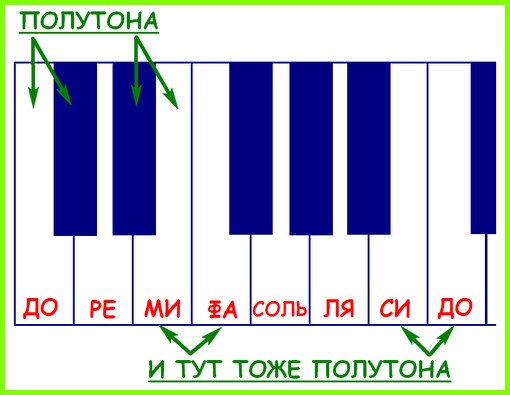
Sharps and flats on a piano keyboard
If a sharp raises a note by a semitone (or you can also say by half a tone), then this means that when we play a sharp on the piano, we need to take a note a semitone higher (that is, the main neighbor). For example, if we want to play C-SHARP, then we play the nearest black key from DO, which is to the right of the white DO (that is, we take the semitone upwards). If you need to play D-SHARP, then we do exactly the same: we play the next key, which is higher by a semitone (black to the right of the white RE).
But what if there is no black key next to the right? Remember our white half-tones MI-FA and SI-DO. How to play MI-DIEZ if there is no black key to the right of it in the upward direction, and how to play SI-DIEZ, which has the same story? And all according to the same rule – we take a note on the right (that is, upward), which is a semitone higher. Well, let it be not black, but white. It also happens that the white keys help each other out here.
Look at the picture, here on the piano keys are signed all the sharps that are in the octave:
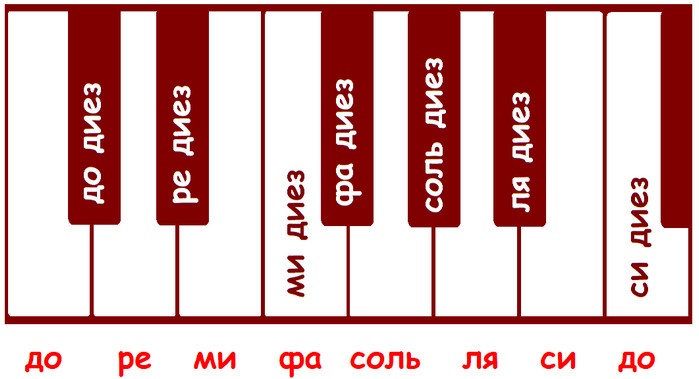
And as for the flats, you probably guessed yourself. To play a flat on the piano, you need to take the key a semitone lower (that is, in the downward direction – to the left). For example, if you need to play RE-BEMOL, then take the black key to the left of the white RE, if MI-BEMOL, then to the left of the white MI. And, of course, in white halftones, notes again help each other out: FA-BEMOL coincides with the MI key, and DO-BEMOL – with SI.
The picture now shows all the flats on the piano keys:
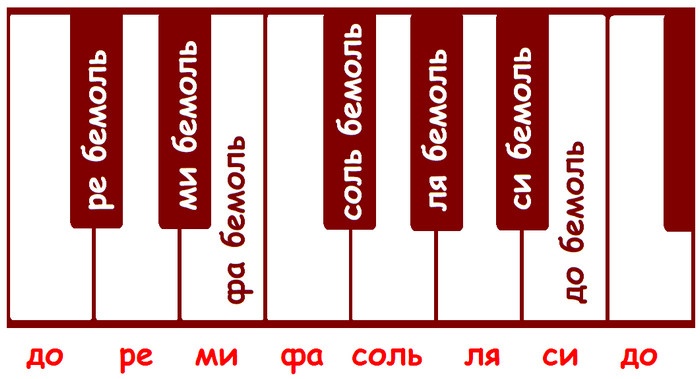
What about double sharps and double flat?
And double-sharp and double-flat – double rises and double falls, of course, change the note by two semitones at once. Two semitones are two halves of a tone. If you connect two halves of something, then you get something one whole. If you combine two semitones, you get one whole tone.
Thus, it turns out that DOUBLE-DIEZ raises the note by a whole tone at once, and DOUBLE-BEMOLE lowers the note by a whole tone. Or two semitones if you like it better.

How to speak and how to write?
RULE # 1. Here we all say: DO-DIEZ, RE-DIEZ, MI-BEMOLE, LA-BEMOLE. But you need to write in notes in a different way, on the contrary – DIEZ-DO, DIEZ-RE, BEMOLE-MI, BEMOLE-LA. That is, a sharp or flat sign is placed in front of the note in advance, like a warning sign for a motorist. It is too late to put a flat or sharp after a note, because a white note has already been played, because it has already turned out to be false. Therefore, it is imperative to write the desired sign before the note.

RULE # 2. Any sign must be placed exactly on the same ruler where the note itself is written. That is, the sign should be next to the note, it is like a guard guarding it. But sharps and flats, which are written on the wrong rulers or even fly somewhere in space, are wrong.
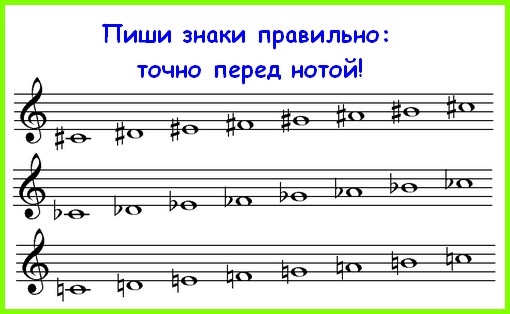
Key and random sharps and flats
Sharps and flats, that is, signs of alteration, are of two types: KEY and RANDOM. What’s the difference? First, about random signs. Here everything should be clear by the name. Random ones are those that come across in the musical text by chance, like a mushroom in a forest. A random sharp or flat is played only in the musical measure where you found it, and in the next measure, the usual white note is played.
Key marks are those sharps and flats that are displayed in a special order next to the treble or bass clef. Such signs, if any, are placed (reminded) on each note line. And they have a special effect: all the notes that are marked with sharps or flats at the key are played as sharps or flats until the very end of the piece of music.
For example, if after the treble clef there are two sharp notes – FA and DO, then wherever we come across notes FA and DO, we will play them with sharp. True, sometimes these sharps can be canceled by random backs, but this, as you already know, only for one time, and then they are played again as sharps.
Or another example. After the bass clef there are four flats – SI, MI, LA and RE. What do we do? That’s right, wherever we come across these notes, we play them flat. That’s all the wisdom.

Sharp order and flat order
By the way, key signs are never placed after the key at random, but always in a strictly established order. Every self-respecting musician should remember these orders and always know them. The order of sharps is: FA DO SOL RE LA MI SI. And the order of flats is the same order of sharps, only topsy-turvy: SI MI LA RE SOL DO FA.

That is, if there are three sharps next to the key, these will necessarily be FA, DO and SALT – the first three in order, if five, then FA, DO, SALT, RE and LA (five sharps in order, starting from the beginning). If after the key we see two flats, then these will certainly be SI and MI flats. Do you understand the principle?
And now one more important thing. The fact is that key signs are displayed not only in a certain order, but also always on the same rulers. In the picture that will be presented below, you will see the correct position on the stave of all seven sharps and seven flats in the treble and bass clef. Look and memorize, or even better – rewrite it several times in your music book. Stuff your hand, as they say.
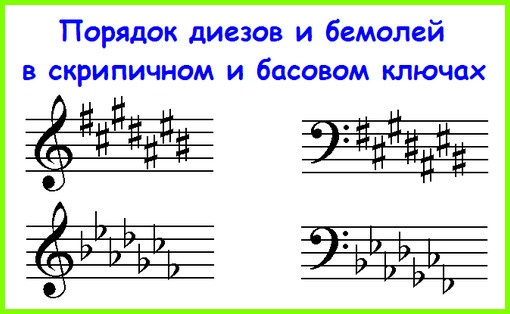
Designation of sharps and flats by letter system
You’ve probably already heard that there is a system of lettering sounds. According to this system, the notes are written in the letters of the Latin alphabet: C, D, E, F, G, A, H. Seven letters correspond to seven notes DO RE MI FA SOL LA and SI. But to designate changed notes, instead of the words sharp and flat, the suffixes IS (sharp) and ES (flat) are added to the letters. You can read more about this and what features and exceptions to the rules are in the article “Letter designation of notes”.
And now – a musical exercise. In order to better remember what sharp, flat and bekar are and what are their strengths, together with the guys from the “Fidgets” ensemble, learn L. Abelian’s song from the collection “Funny Solfeggio” about these signs (watch the video).



